Rutile - the Titanium Crystals
Rutile is a mineral of many forms and colors. It is quite widespread accessory mineral in many rocks but nice crystals are much less common. Rutile is also important source of titanium and has various industrial applications.
Chemists succeeded in creating synthetic rutile in 1948, to no real effect. The artificial product has an adamantine luster, is transparent and nearly colorless, looks diamond-like, and was marketed as a diamond substitute under the name Titania (an old historic name), but is actually unsatisfactory for jewelry use because it is too easily scratched.
Crystal Structure of Rutile
Rutile is a member of the tetragonal crystal system, it is a simple titanium dioxide TiO2. Rutile is ordinarily prismatic, with distinct cleavage. Prisms may be striated vertically or furrowed. Prisms are rarely pyramidal. In igneous rocks, rutile can be granular or massive. Rutile is brittle, and tends to fracture along flat surfaces.
Rutile is one of the TiO2 polymorphs, others include: anatase (tetragonal), brookite (orthorhombic) and akaogiite (monoclinic).
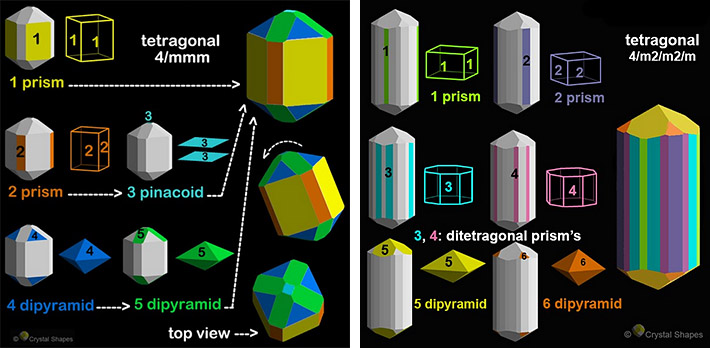
Rutile has the lowest free energy among the polymorphs, such that the transition from one of the other polymorphs to rutile is not reversible. Furthermore, rutile has the highest molecular density among the four, so that in the deep mantle, high-pressure environment where titanium occurs, rutile is the primary mineral expression of it. The needle-like yellow variety of rutile is called sagenite, it is usually incorporated in other minerals. Sagenite is often present inside the crystals of clear or smoky quartz, such specimens are known as rutilated quartz.
Rutile can accomodate significant amount of other elements, especially Fe, Nb and Ta. Iron rich variety is black and sometimes known as nigrine. Nb-rich rutile is also known as niobian rutile or ilmenorutile, Ta-rich rutile is known as strüverite.
Rutile is very often twinned. V-shaped twins - also known as elbow twins - are very abundant at some localities and even cyclic sixlings or eightlings are known. Rutile also forms epitactic growths with hematite, especially in alpine type veins. Other epitactic growths form with ilmenite, magnetite, anatase and brookite.
Physical Properties of Rutile
The color of rutile is characteristically silver (metallic), black, dark gray, blood red to reddish, brownish red, yellow; even bluish or violet. Along with the color changes, there are subtle changes in luster, ranging from mirror-like metallic to sub-metallic. Opaque metallic specimens can display reddish translucency on their edges.
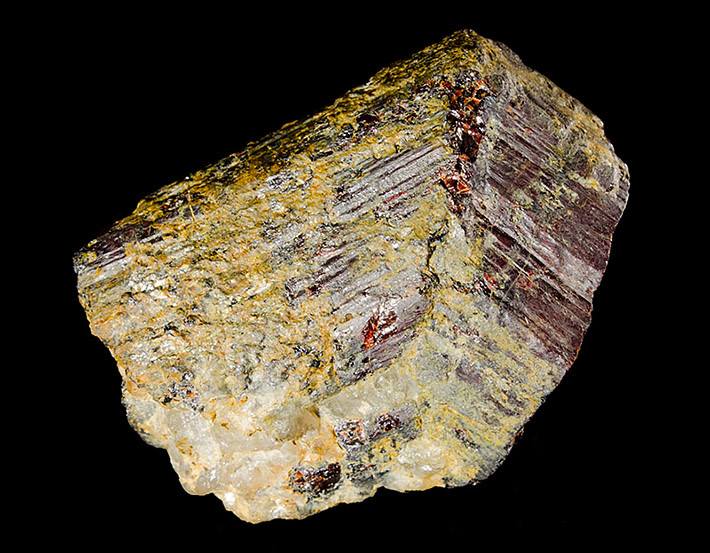
The name rutile comes from the Latin rutilus (reddish), a reference to the characteristically deep red color.
Rutile has a hardness of 6.5, with an unusual grayish-black streak, and a density of 4.25. By weight, rutile is 59.94% Ti and 40.06% O.
Birefringence
By itself, rutile has one of the highest refractive indices among common minerals, meaning that the speed of light in air is very much higher than the speed of light in a rutile crystal. When a specimen is rotated on a microscope stage in transmitted plane-polarized light, the differences in color are extreme.
Asterism
Asterism is the production of shimmering or chatoyancy caused by the tiny needles of rutile within the matrix of another mineral. Clusters of tiny rutile needles, whether aligned in parallel or randomly dispersed, can create a shimmering optical effect, which materially raises the appraised value of gemstones. When present in a gemstone, such as sapphire or ruby, the asteriated mineral is called star, as in star sapphire or star ruby, and commands a higher price in the marketplace. Not all forms of asterisms are caused by the rutile inclusions though.
Origin of Rutile
Rutile occurs in two principal environments. In the high-pressure environment of the deep mantle, the mineral is expressed as a primary titanium mineral in eclogites, rocks generally consisting of mixtures of clinopyroxene and garnet, +/- orthopyroxene, olivine, and chromium mica (fuchsite). If those rocks gradually rise in the crust through tectonic activity, they may become partially hydrated and erupted as mafic igneous and volcanic rocks, also still containing rutile. In these environments, rutile is an accessory mineral.
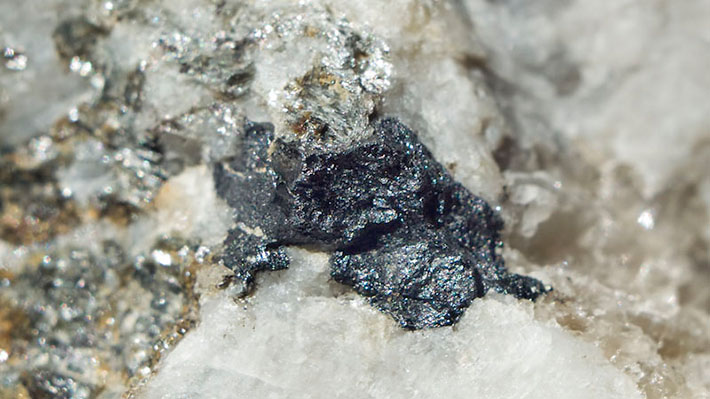
The other modality of occurrence is when these eclogites and mafic rocks are eroded at the surface, particularly in the Pacific Ring of Fire, where converging continental and oceanic plates are uplifting continental masses exposing mafic rocks. The eroded minerals selectively accumulate as beach sands along shorelines, where wave action continually sorts and reconcentrates them to the point of economic viability. In these environments, rutile is a detrital mineral.
In some igneous rocks, weathering of the matrix will promote the destruction of ilmenite, which alters irreversibly to leucoxene, a granular aggregate of rutile or anatase. Classically, leucoxene is described as ranging in color from yellow to brown, but it also occurs in altered basalts as extensive white patches resembling guano.
Even some felsic magmatic rocks - like some granites or pegmatites - could contain rutile.
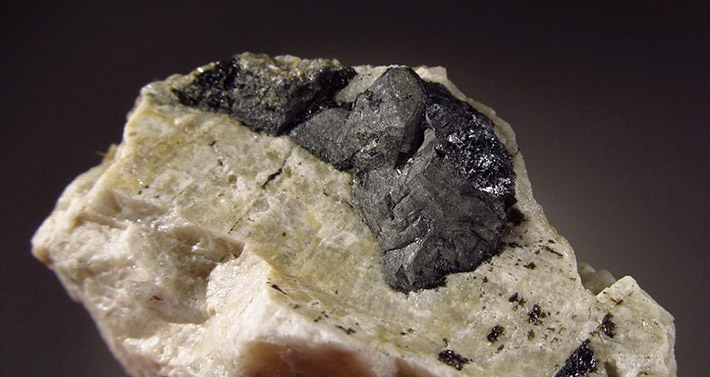
Rutile is also present in some metamorphic rocks, especially gneisses, schists and amphibolites. Some of these rocks contain quartz lenses with rutile crystals, sometimes weighting up to several kilograms. Rutile can be also dispersed within the rock in the form of tiny crystals.
High quality crystals of gemmy red rutile or yellow sagenite come from Alpine type veins. Rutile can be present in the form of regular growths of yellow or brown-yellow needles of sagenite. Gemmy red rutiles grow inside the pockets and sometimes form epitactic growths with Alpine hematite variety - iron rose.
Applications of Rutile
There are no important historical uses for rutile. In the modern world, the titanium extracted from rutile is used to create refractory ceramics and to harden steel. Powdered rutile (titanium white) is the world's principal source of white pigment used in paints, and any other application requiring a bright white finish. Rutile and ilmenite are also main titanium ores.
Rutile as a mineral specimen can be powdered to create a brilliant white pigment applied to many plastic, paper and food products where bright whiteness is a prerequisite. Its use as a paint pigment is the largest dedicated use of titanium dioxide worldwide.
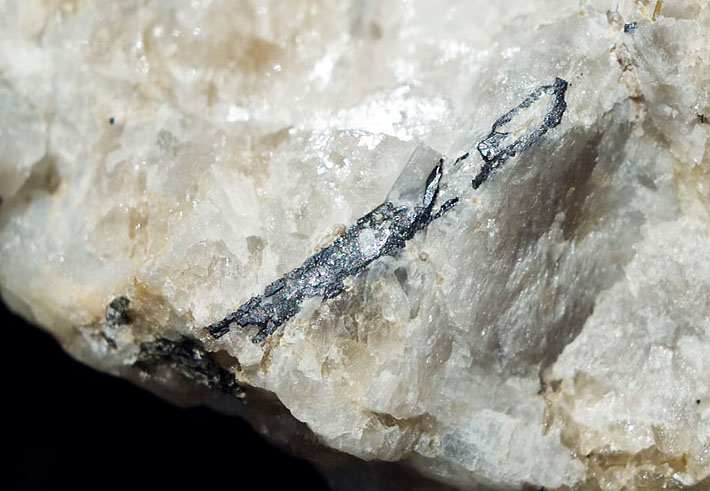
In addition, scientists discovered that when rutile is reduced to nanoscale size, the particles are transparent to visible light but absorb UV light. This property allows incorporating rutile nanoparticles into sunscreen lotions to protect against UV-induced skin damage. At the other end of the electromagnetic spectrum, scientists have used the birefringence properties of rutile to explore longer visible and infrared wavelengths in studies of light polarization.
Industrial Production
The industrial center of rutile production in the 1990s was Sierra Leone, in West Africa, where the existing reserve of hundreds of millions of tons of detrital rutile trapped in gravels made it the leading producer for the foreseeable future, but civil war and rapid exhaustion of deposits drastically impacted its standing.
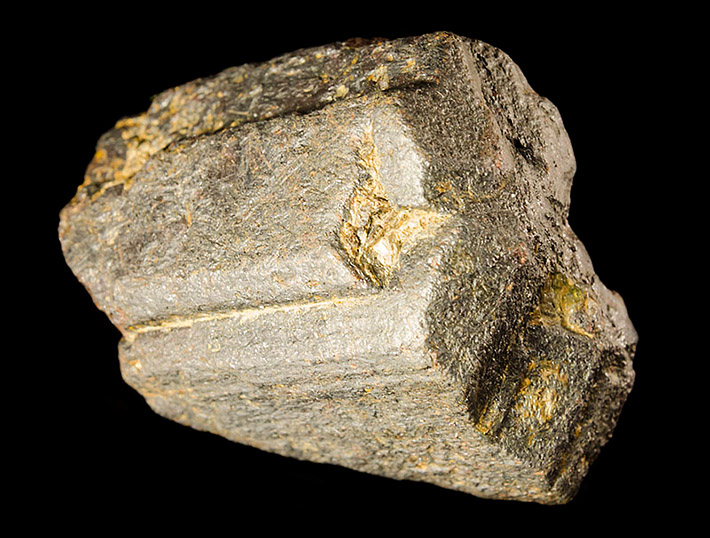
In 2016, the leading rutile producers, (in hundreds of metric tons) are Australia (280), South Africa (130), Sierra Leone (67), Ukraine (57), India (20), Sri Lanka (12), Madagascar (6), Brazil (3), and Mozambique (2).
Occurence of Rutile
Collection-worthy specimens are not very common. The classic localities are often places where the country rocks are metamorphosed peraluminous schists containing the assemblage andalusite-sillimanite-kyanite. This suite is critically important because it is a definitive indicator of metamorphism in the pressure-temperature conditions of the (hornblende-stable) amphibolite-facies (Hornblende is the diagnostic mafic mineral indicator of amphibolite-facies P-T conditions).
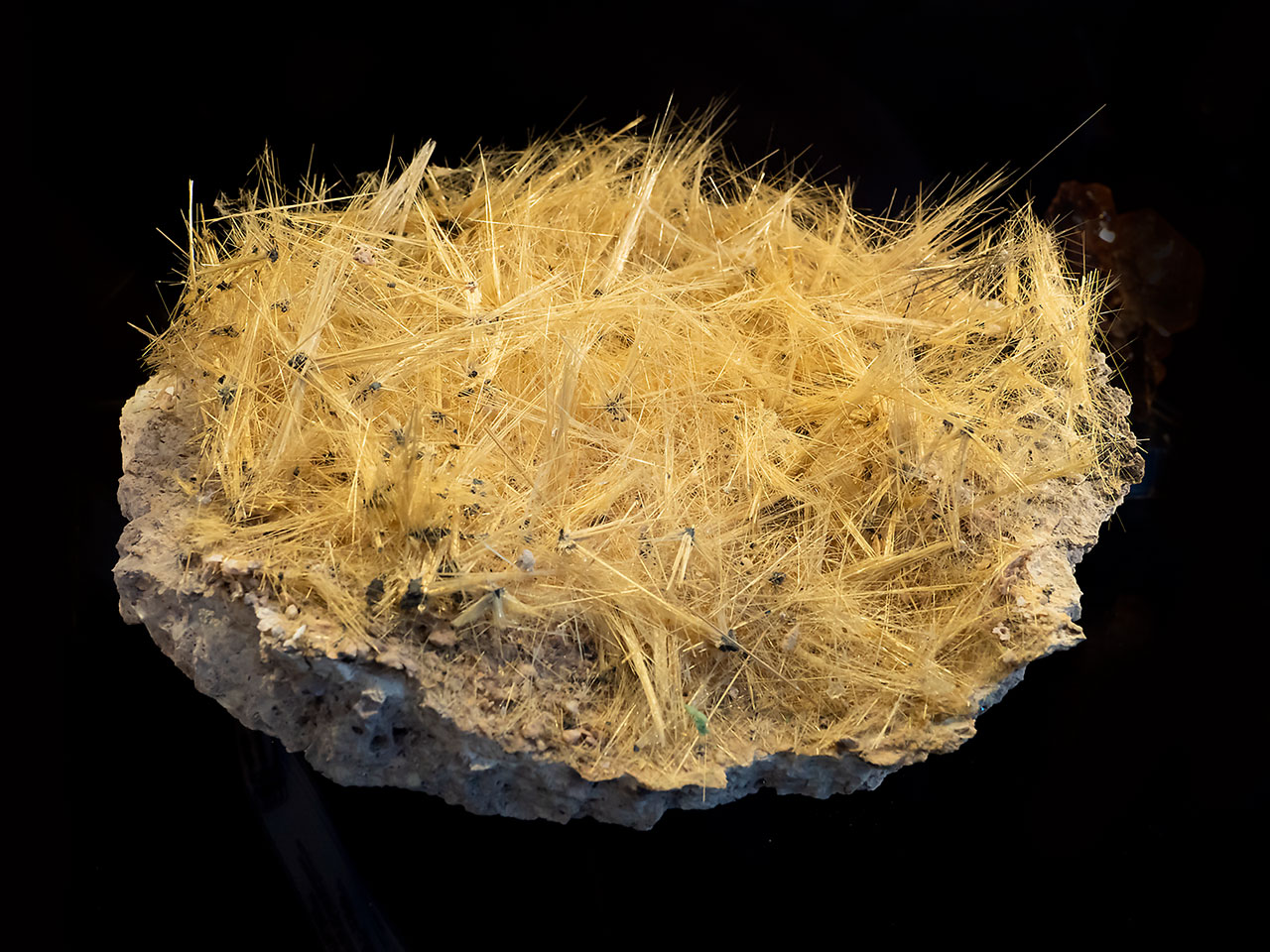
Although some mineral inventory sites list over 3400 localities for specimen-quality rutile, only few localities are well known.
Magnet Cove, Hot Spring County, Arkansas: Rutile is hosted in a breccia pipe from the mantle. Graves Mountain, Lincoln County, GA: Rutile is hosted by metamorphosed sericite schists. Parkesburg, Chester County, PA: Rutile is hosted in folded and metamorphosed Cambro-Ordovician sediments. Nice rutile crystals with pyrophyllite occur in Champion Mine, Mono Co. in California.
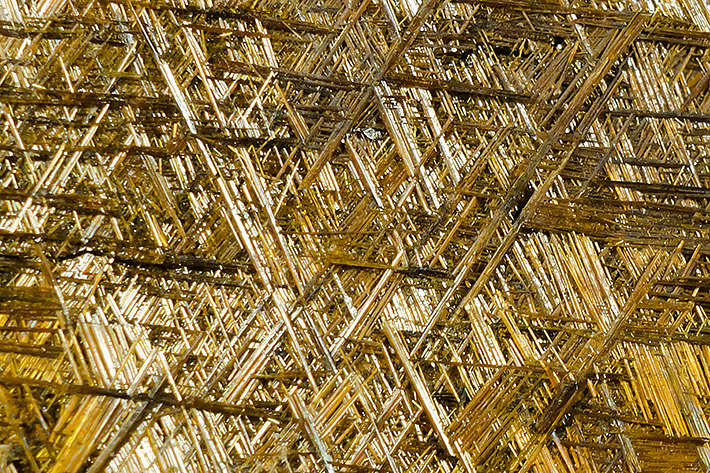
Graubunden Canton, Switzerland. Rutile host is undetermined. Kaputdzhukh Mountain. Syunik Province, Armenia. Rutile is hosted in volcanic rocks. Zambia. Rutile is hosted in central provinces in peraluminous schist with kyanite.
An area which ought to be a viable prospecting ground is the Acadian Mountain terrain in New Hampshire and Maine in the US, where a great deal of the triple-point research was conducted. Rocks in that area are rife with triple-point assemblages, and there are any number of papers in the petrologic literature documenting specific sites of study.
Great oriented growths of hematite and yellow sagenite come from Novo Horizonte, Bahia, Brazil. Great gemmy red crystals are found in Diamantina, Brazil. Exceptional hematite and rutile epitactic growths are found in Mwinilunga, Zambia.
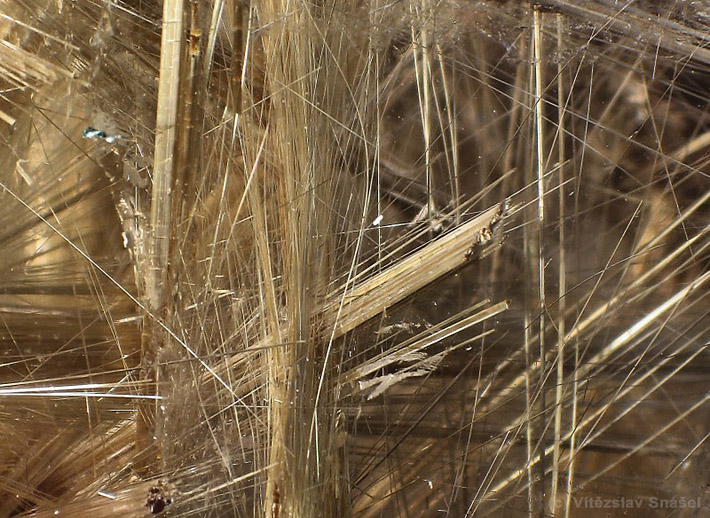
Numerous alpine localities include Cavradi and Binn Valley in Switzerland, Stubach Valley in Austria and Susa Valley and Carrara in Italy. Sagenite in the form of rutilated quartz comes from numerous localities in the Alps, from Brazil, Russia and numerous localities worldwide.
Gneisses near Zverotice, Golcuv Jenikov and Ledec nad Sazavou, Czech Republic, produced nice twins and hexlings. The biggest known cyclic hexling was over 12 cm large.
Strüverite is known from numerous pegmatites in Madagascar, Brazil, Czech Republic and USA. Niobian rutile (ilmenorutile) is also often present in various pegmatites. Nigrine is abundant in Haggendorf area, Germany.





Comments